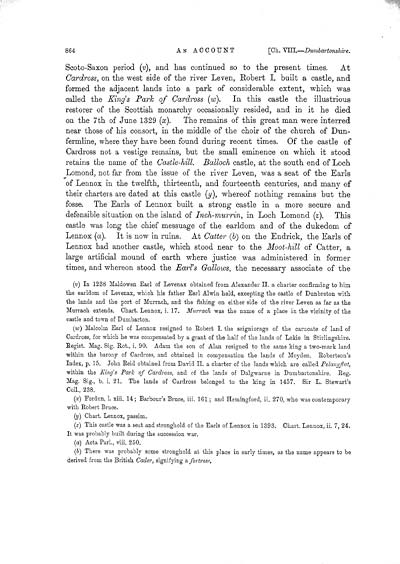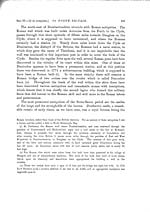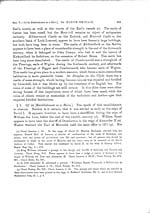Volume 6
(425) Page 864
Download files
Individual page:
Thumbnail gallery: Grid view | List view

864 Scoto-Saxon period (v) and has continued so to the present times. At Cardross, on the west side of the river Leven, Robert I. built a castle, and formed the adjacent lands into a park of considerable extent, which was called the King's Park of Cardross (w). In this castle the illustrious restorer of the Scottish monarchy occasionally resided, and in it he died on the 7th of June 1329 (x). The remains of this great man were interred near those of his consort, in the middle of the choir of the church of Dun- fermline, where they have been found during recent times. Of the castle of Cardross not a vestige remains, but the small eminence on which it stood retains the name of the Castle-hill. Balloch castle, at the south end of Loch Lomond, not far from the issue of the river Leven, was a seat of the Earls of Lennox in the twelfth, thirteenth, and fourteenth centuries, and many of their charters are dated at this castle (y), whereof nothing remains but the fosse. The Earls of Lennox built a strong castle in a more secure and defensible situation on the island of Inch-murrin, in Loch Lomond (z). This castle was long the chief messuage of the earldom and of the dukedom of Lennox (a). It is now in ruins. At Catter (6) on the Endrick, the Earls of Lennox had another castle, which stood near to the Moot-hill of Catter, a large artificial mound of earth where justice was administered in former times, and whereon stood the Earl's Gallows, the necessary associate of the (v) In 1238 Maldowen Earl of Levenax obtained from Alexander II. a charter confirming to him the earldom of Levenax, which, his father Earl Alwin held, excepting the castle of Dunbreton with the lands and the port of Murrach, and the fishing on either side of the river Leven as far as the Murrach extends. Chart. Lennox, i. 17. Murrach was the name of a place in the vicinity of the castle and town of Dumbarton. (w) Malcolm Earl of Lennox resigned to Robert I. the seigniorage of the carucate of land of Cardross, for which he was compensated by a grant of the half of the lands of Lekie in Stirlingshire. Regist. Mag. Sig. Rot., i. 90. Adam the son of Alan resigned to the same king a two-mark land within the barony of Cardross, and obtained in compensation the lands of Moyden. Robertson's Index, p. 15. John Reid obtained from David II. a charter of the lands which are called Pelanyflat, within the King's Park of Cardross, and of the lands' of Dalgwarne in Dumbartonshire. Reg. Mag. Sig., b. i. 21. The lands of Cardross belonged to the king in 1457. Sir L. Stewart's Coll., 238. (x) Fordun, 1. xiii. 14; Barbour's Bruce, iii. 161; and Hemingford, ii. 270, who was contemporary with Robert Bruce. (y) Chart. Lennox, passim. (z) This castle was a seat and stronghold of the Earls of Lennox in 1393. Chart. Lennox, ii. 7, 24. It was probably built during the succession war. (a) Acta Parl., viii. 250. (6) There was probably some stronghold at this place in early times, as the name appears to be derived from the British Cader, signifying a fortress.
Set display mode to:
![]() Universal Viewer |
Universal Viewer | ![]() Mirador |
Large image | Transcription
Mirador |
Large image | Transcription
Images and transcriptions on this page, including medium image downloads, may be used under the Creative Commons Attribution 4.0 International Licence unless otherwise stated. ![]()
| Caledonia, or, An account, historical and topographic of North Britain from the most ancient to the present times > Volume 6 > (425) Page 864 |
|---|
| Permanent URL | https://digital.nls.uk/74531880 |
|---|---|
| Description | Vol. VI. |
|---|---|
| Attribution and copyright: |
|

